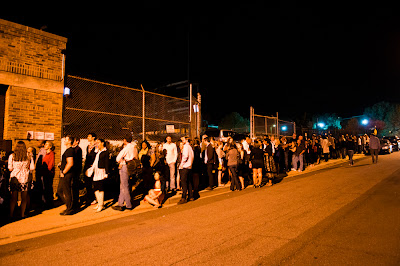 |
| During the performance "The Trash Project" in Austin in 2009 |
I
thought of this line from Harvard’s 2008 report called “A Vision for the Arts” while
watching the film “Trash Dance.”
A
documentary directed by Andrew Garrison and featuring choreographer Allison
Orr, “Trash Dance” takes its name from a project Orr created in 2009 featuring
employees and vehicles from Austin’s Solid Waste Services Department. Orr spent
a year with the men and women who collected garbage, dead animals, and
recyclable material. She accompanied them on their routes, asked them questions
about their lives, and learned about the multiple jobs they held and talents
they possessed. She wanted to both
learn about the people “who pick up my trash” and make a performance that shed
light on their unique lives, movements, and skills. Their show, called “The
Trash Project,” happened only one time on an abandoned airport runway in Austin for an audience
of a couple thousand people. Thanks to Garrison’s film, thousands more are now
viewing highlights of that evening as well as the poignant and at times
hilarious moments that led to its creation.
This
is one way to describe the film I watched at the AFI Silver last week,
but it fails to capture the many ideas and questions that it set
in motion. Orr is both a gifted listener and a personable, charismatic leader,
traits that enrich her process and her creations. One of the first scenes shows
her interacting with the employees as she describes “The Trash Project” to a
large group of men. Orr’s enthusiasm and sincerity pose a stark contrast to
their suspicion and disbelief. As she perseveres, the men shift as well.
Ultimately her cast consists of 24 men and women and 16 of their vehicles. Before
we see their performance, Garrison’s cameras follow them through their routes
as well as their daily lives: we see a single father raising a
young girl, a woman’s passion for boxing, and Orr trying to explain to some
employees what contemporary dance is after they ask if she dances ballet. Her reply is, “It’s
done barefoot.” In a director’s statement Garrison writes: “Orr told me 90% of her job, at first, is to listen to people.
Not just observing their movements, but hearing their concerns—about their
family, about work and how they view the world. At this point I knew that if
she actually did that, there would be a film.”
“Trash Dance” is a stunning film, and
the night in Silver Spring when I saw it, people in the theater spanned several
generations. In some ways the crowd the film attracts can be as eclectic as the
people in the movie itself. I started to wonder if this was one of Orr’s goals: to explore how a performance can open up different
ways of getting to know one another, of listening to stories, and of fostering
a sense of connection. As she writes in her choreographer’s statement: “I
wanted to make a dance that offered a more fully human picture of the people
who work as ‘trash men,’ and I wanted the audience and the performing employees
to feel more connected to each other once the performance was over.”
There are moments in the performance
that are breathtaking: a crane that emerges from a vehicle operated by Don
Anderson rises like a snake emerging from a charmer’s basket. Anderson works
the machinery with the grace and precision of an origami maker folding a sheet
of paper. His duet with the vehicle transforms the apparatus into a flying crane,
stunning and dramatic. Another
highlight of the performance is a solo by Anthony Phillips, a Litter Abatement
employee whose dancing fuses Fred Astaire with Lil Buck.











